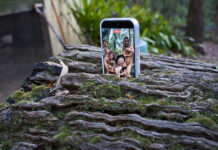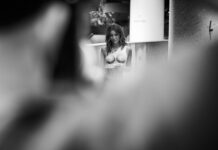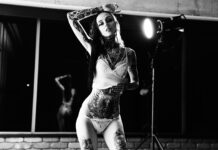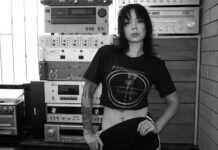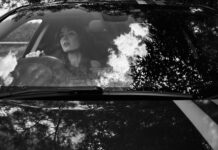I wrote this a couple of months ago and was going to revisit before posting, but here it is.
I’ve been shooting quite a bit of film lately – for a while now, really. I started my photography journey on digital and don’t have a beautiful story of a parent or grandparent shooting film and that’s why I picked a camera, etc, etc – but I’m sure I already mentioned that in a previous post.
So why shoot film, I’m asked? It’s expensive, slow to shoot, I have to wait to see the results… Every time I’m asked this question I find it very hard to explain, so this is my attempt on an explanation.
I’ll make a short story long.
And I promise I’ll not talk about “grain”.
Story Telling

My favourite photographer and inspiration, Peter Lindbergh, only transitioned to digital photography because he had “no choice”, as he says. Wim Wenders, my favourite film-maker – and Peter’s friend -, believes he took over 12,000 Polaroids between 1973 and 1983.
An exhibition of Wenders’ Polaroids in London, called “Instant Stories”, hosts an extensive collection of his Polaroids. But only around 3,500 Polaroids remain. “The thing is,” Wenders says, “you gave them away. You had the person in front of you, whose picture you had just taken, and it was like they had more right to it. “
Working as a photographer, I produce thousands of photos every year, and although I can recall every shoot and stories about each shoot, I can’t talk about each of the hundreds of photos from a session.
Photography as a Job

Being so busy with photography as a job, I now have less time to shoot for myself. When I decided to be a full time photographer I worried about at some point not loving photography anymore, and shooting film helps me fall in love with photography over and over again.
I sometimes shoot a roll of film when shooting an editorial for myself, and more often than not those pictures are my favourites from the whole shoot.
When I take a picture with a film camera, that capture matters. It’s not like pointing my phone or digital camera at something to try to quickly record a moment or take lots of frames to get the perfect photo: the cost of film makes me care more about what I’m capturing.
My Mamiya doesn’t even have a light meter, so a lot more thought goes in to every single frame. Not to mention every photo I take on that camera costs anywhere between A$5 and A$7 and I only get 12 exposures out of a roll.
Slow it Down
I think that the old cameras with their negatives forced the photographer to anticipate because he could not recheck. He/she had to rely on the relation to the motive and to the light. He/she couldn’t just think about how he/she will change the image afterwards.
– Wim Wenders
To make a photo like the above work, so much has to happen. I’m forced to see the light. I move around looking at people’s faces and the scene to see if there’s a picture there. I have to slow down and think about what I’m doing. What my settings will be, what I want my subject to be doing. I have to prepare for my image. And then I have to wait. Wait for my subject to give me something (or make it happen).
That helped me slow down even when shooting digital, which makes my life easier later as I have less photos to go through.
And there’s also failure. Sometimes I’ll get things wrong and it’s ok. When I see the photos I think: well, I know what to do next time.
Waiting for my photos to be developed and scanned is another interesting thing. I don’t have a lot of patience for waiting, in general, as I’m so into workflows and processes and automation and making things happen fast and accurately – when shooting film, I have no option other than wait.
And the feeling when that email reaches my inbox with the subject “We’ve got scans for you!”… Ah that’s amazing. There’s no leaving that for later, I need to see them straight away!
The Film Community

The film community is a beautiful one. Often people refer to them as hipsters, and some film shooters are, but that doesn’t really matter.
I met Josh because of film. He invited me to be part of his YouTube channel and I’ve done that a few times and we became friends.
And then there’s the lab. I started shooting film when I found Racquet was around the corner from where I lived. Back then I only had a Canon EOS 500, but that didn’t stop me – and also didn’t stop me from buying more film cameras (I own more film cameras than digital cameras).
Racquet is not the cheapest lab around, but as the saying goes, you get what you pay for, and their work is amazing. I also built a relationship with them, knowing them by name and them knowing me by name.
Perfection is not Always Important

When shooting film, sometimes I get photos that are not perfect, or “wrong”. Above photo of Annaliese was taken after I’ve been shooting digital a lot and I completely forgot to focus *facepalm*!
Yet, I love this photo.
Of course we all see things differently, but this image works for me. I see so much in it.
This next image, taken with the Mamiya, is also a bit out of focus (no, not as much as the previous photo):
The “Feel” of Film

People often talk about the “feel” of film. That’s one I cannot explain, but I see it.
Film photos have something that makes them timeless, and I can feel the place or the emotion more than with digital photos. Digital cameras and modern lenses produce images that are too sharp, too technical. Of course I can then edit them and make them into whatever I’d like, but looking at a film photo brings me closer to the subject somehow.
When looking at my portraits taken on film, I see more emotion, and that sparks something else other than just a “nice photo”.
And the feeling when a photo turns out better than I could ever imagine? After all the wait for those 36 (37 or 38 if you’re lucky) exposures from your roll, I see one that makes me go “wow”!










Learning the Craft

You have to actually know what you’re doing, to shoot film. You have to really understand photography and light if you want to shoot film, otherwise it will be a very expensive wasted experience.
It’s hard to explain how satisfying it is to get to the point where I can just look at a scene, look at the light, and know what my settings should be before using the light meter! Even when I’m not spot on, it makes it easier to just calculate the changes I have to make.
Conclusion

I am today a faster film photographer, but it still slows me down when comparing to digital. I love the experimentation, the time needed to get the shot, the time waiting to see my scans. I love the feeling in my photos and it keeps me in love with the art of creating images and capturing moments and emotions.


